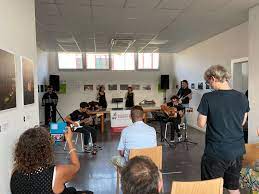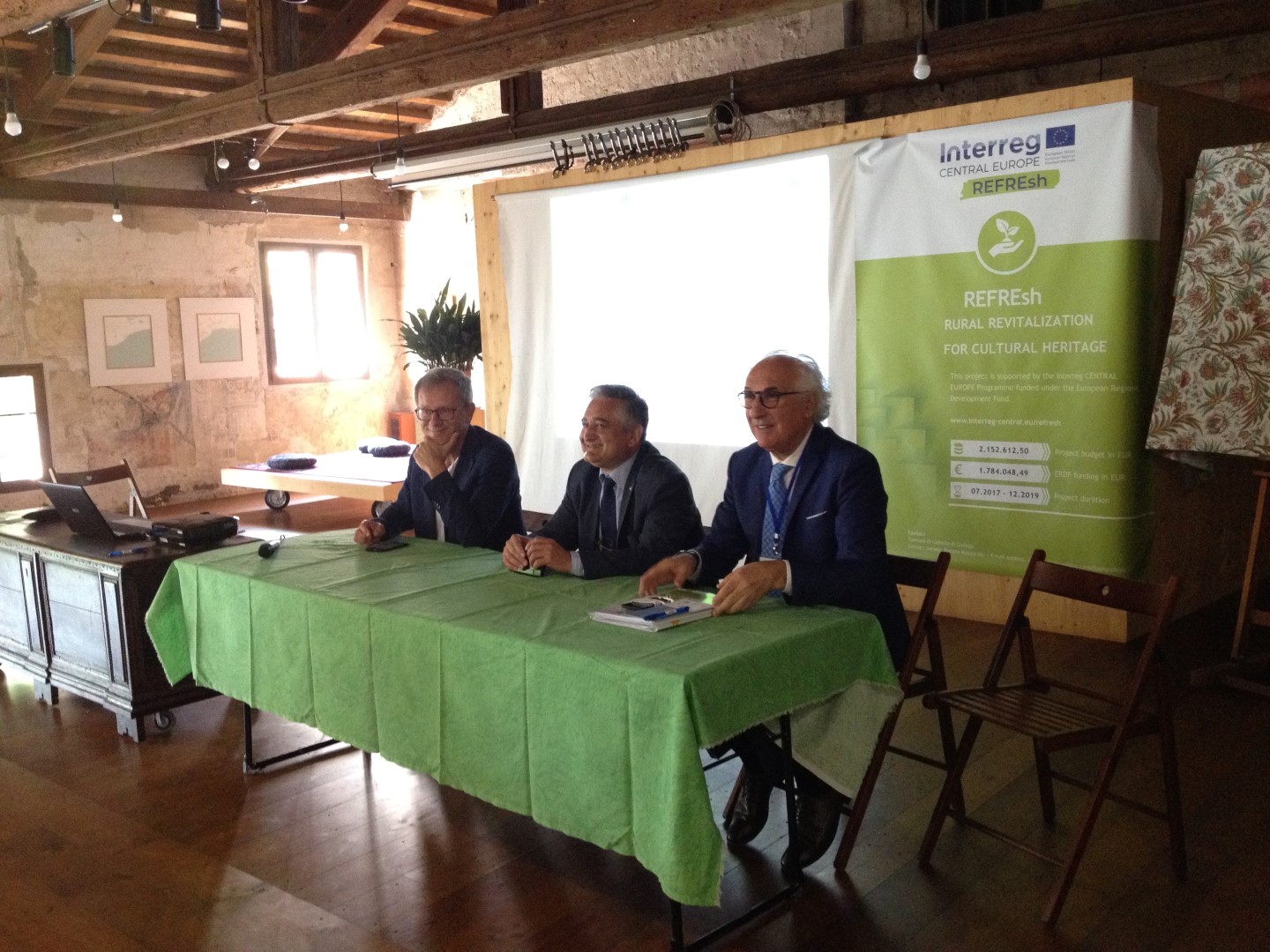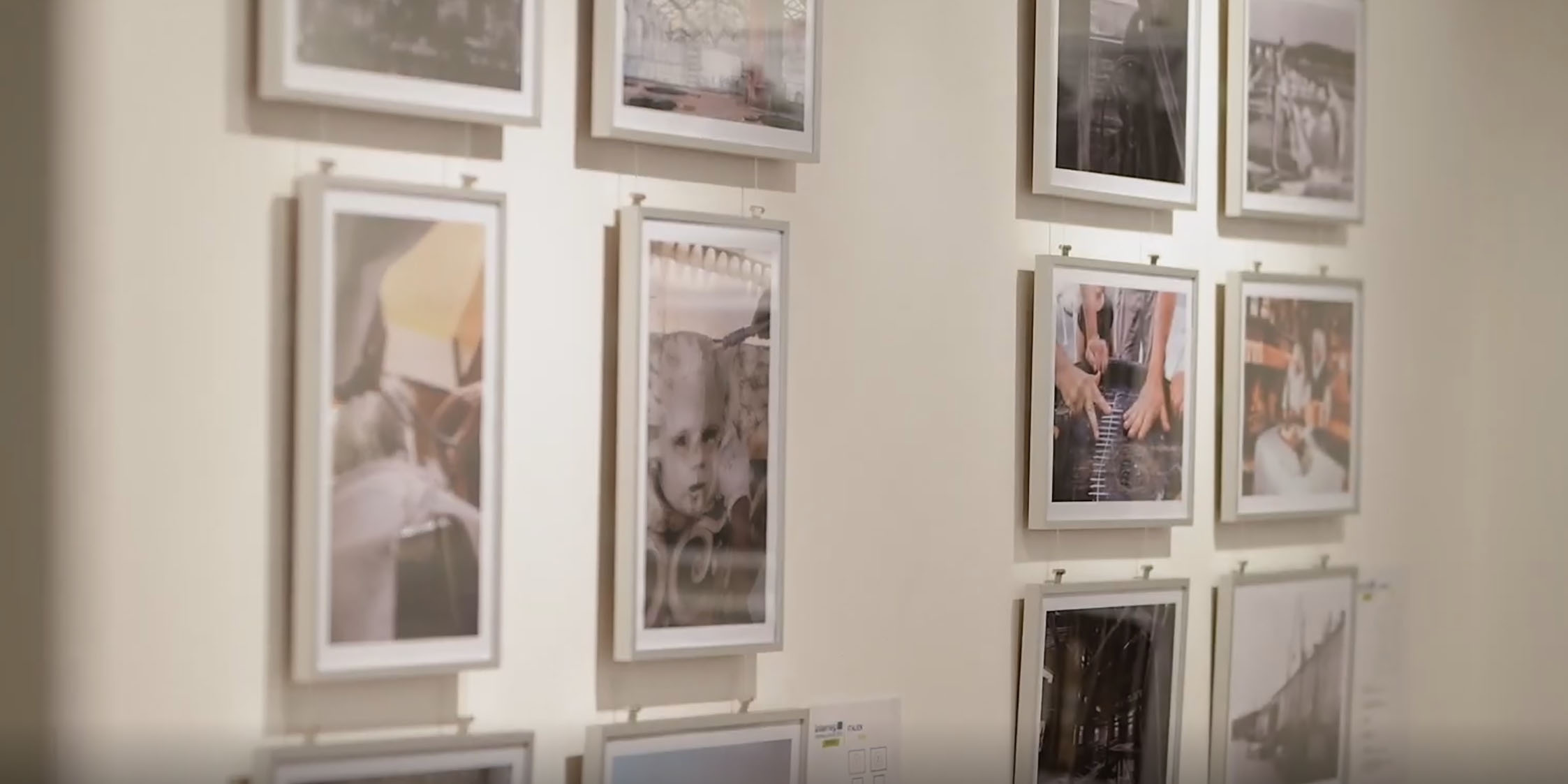Integration of the creative scene focused to test the reutilization of the unused industrial heritages spaces as cultural centers:a starting point to show how old industrial heritage transformed into cultural centers could be a starting point for development of the industrial areas,municipalities,and regions in CE.The pilot actions included exhibitions,cultural events and creative workshops,with the intention to reach the local community,a critical mass of creative actors and foster cooperation
Chemnitz
Jadranska Hrvatska
INTERREG CENTRAL EUROPE
Programme priority: 3. Cooperating on natural and cultural resources for sustainable growth in CENTRAL EUROPE Programme priority specific objective: 3.2 To improve capacities for the sustainable use of cultural heritage and resource
2017-2020
REFREsh tackled the main challenges of rural areas in CE regions. Unused industrial heritages exist which need a revitalization and a new form of use. One approach often Cities use is to involve creative scene in the reutilization of industrial heritages and areas. In rural areas this often fails through a missing critical number of creative actors to sustainable reutilize the industrial sites alone. For that a multifunctional approach it has been considered necessary to combine the established stakeholders from trade, industry and services with the creative scene. Just by working together in close cooperation we have reached a mutual added value and sustainable reutilization of the sites. The main objectives of REFREsh were therefore to reutilize industrial heritages through new forms of creative use and attract new creative actors for valorize the industrial heritage in cooperation with actors from trade and service sector. The partnership consisted of Municipalities, regional and cultural actors from 5 countries in CE bundle their competences to provide benchmark tools for analyzing territorial situation and combination options for creative,trade,and service actors,develop regional strategies for the integration of creative scene in the reutilization of industrial areas into cultural attractive places in cooperation with trade and service sectors.The projects transformed industrial heritages into cultural centers for creative scene as starting point for development of the industrial areas, Municipalities and regions in CE.To reach enough creative actors and foster transnational cooperation of creative scene transnational exhibitions,cultural events and creative workshops have been implemented in the reutilization to attract creatives in taken part in reutilization and increase competence form politicians,planners,site managers how to integrate creative scene for the joint development of industrial areas that had become the starting point for further reutilization
Please highlight how the project can be exemplary in this context
In the case of REFREsh sustainability must be, according to criteria of conservation and restoration, compatible with the intrinsic value of the historical and artistic heritage both at material and aesthetic level. REFREsh have positive effects to sustainable development goals: through the reutilization of old industrial heritages, the integration in of creative scene beside trade and service sectors and promotion of industrial heritages new and more offers are built for tourists and inhabitants for a greater attractivity of the City and whole region and improved city live.
The project has been linked to the status of capacities of the public and private sector for the sustainable use of cultural heritage and resources achieved in the following way: by developing and testing of innovative concepts for reutilization the project partner got management competences to develop and establish new reutilization approaches and build up institutional capacity. Additionally, the tested reutilization concepts became transferable in regions and central Europe capacity from public authorities, economic development actors and site mangers for multifunctional regional development. In terms of circularity, positive effects occurred through actions for more energy efficiency and use of natural resources like rainwater; for management environmental-friendly behaviour, face to face meetings have been organized only just if necessary and combined with other events. Moreover, it has increased capacity of political makers and planners to combine different sectors trade services; created an industrial thematic route together with partner settlements; reutilization for creative use of other industrial areas; reutilization of industrial heritages for cultural purpose, integration of creative scene to realize revitalization projects for development.
Please highlight how the project can be exemplary in this context
The study of technologies and materials, the products, the methodological approach were also derived from previous studies that led to the national regulation of historic buildings. All interventions are based on the conservative and aesthetic compatibility, that is: both architectural interventions and operational interventions inside and outside buildings and areas are based on the conservative criteria of the code of cultural heritage related to the different partner nations. Specifically, the attention paid to the aesthetic and historical value of the cultural heritage has been integrated with the aesthetic value of the realized projects. As, for example, the activities of events or production activities located within the historic buildings examined. The interventions designed and implemented in the project, have had the attention to realize the aesthetic part of the cultural heritage examined.
This has meant that the interventions on the structures have not altered the originality of the structure other than improving it, making it affordable and functional for the new use.
Please highlight how the project can be exemplary in this context
By developing the reutilization concepts and test them in pilot actions REFREsh respected the aspects of equal opportunities and non-discrimination by involving also the end-user in the development process of activities to take their needs in consideration. Already planned barrier-free access esp. for disabled persons were foreseen, to allow a better access for this group. By creating the strategy for creative actors’ integration also the social circumstances have been respected to avoid social segregation. Gender equality had little relevance regarding valorization of industrial heritages, but the project gave the potentials to introduce creative actors for creative women esp. in craftsmanship, where there are underrepresented. The fact that one of the goals of REFREsh was the conversion from historical buildings to creative industries by involving private-public actors and individuals, such as co-working spaces - civic space – museums ecc, other than give the right hints to the people involved in the workshops to develop their ideas by using the converted spaces, in this way the project has become explanatory to all the PP’s ecosystems, by encouraging a dialogue across cultures, disciplines, genders and ages. As a matter of fact, how the European Bauhaus imagines to develop beautiful, sustainable and together living spaces and experiences.
Please highlight how this approach can be exemplary
Pooling know-how from different regions and cultural institutions, who faces similar challenges but have different circumstances (e.g. legislations, policies, target groups) and solutions for solving problems, gave the chance to integrate the creative scene in existing spatial and sectoral functions of trade and services: as mentioned this approach is not established in the PPs region. Different realization strategies of this approach have been considered, giving solutions without compromising the local ecosystem. Through different planning systems and ways of handling a more diversity of approaches can be included in the joint development of transitional strategies adapted to regional strategies for integrating creative scene in established sectoral structures. The reutilization of old industrial areas with cultural purpose to protect and valorize cultural heritages in rural areas: Partners adapted to their specific needs pilot projects, where without would have not been successful due to lack of methodology and critical mass of creative scene. Through this contamination method developed through the partners, new concepts have been easily developed, by learning of best-practices to find the best solutions for each region. Additional through the transnational involvement of creative scene from the partner regions and offering the participation on transnational events, exhibitions and workshops during the pilot actions, a critical mass has been reached, attracting further creative actors from PPs regions. Another benefit is to get new views from other perspectives because of different approaches handling reutilization and promoting in different countries in CE, used to adapt solutions to each own specific country situation.
The local projects transform industrial heritages into cultural centers for creative scene as starting point for the development not only for the partners that were involved, but also of the industrial areas, municipalities and regions in CE. To reach enough creative actors and foster transnational cooperation of creative scene transnational exhibitions, cultural events and creative workshops have been organized in the reutilization process. This has become essential for the side of the long-term effect, because brought the areas to attract creatives in order to take part in the reutilization ex abandoned areas and increase competences of politicians, planners, site managers on how to integrate creative scene in the joint development of industrial areas. As well, the wide network it has continued to involve SMEs and creative actors in regional workshops for analysis and cooperation and to invite stakeholders in transnational peer reviews an involvement of cultural actors.
The project brought a physical transformation of places through a participatory process. The conversion of from historical buildings to creative industries has shown that transformation and regeneration can build environments that continue to stay connected with local historical heritage and traditions, other than contributing to restore pride, shaping future oriented ambitions for the communities, therefore reproposing the spaces toward positive intergenerational exchanges and community building.
Please also explain the benefits that derived from their involvement.
The understanding of the output and the objective was to create an analysis basis for the territorial situation, detect best-practices for integration and reutilization during the project, and analysis of target group needs contributed from all partners. The best practice analysis served to find appropriate possibilities for reutilization, integration of creative scene. All partner analysis best-practices from former projects or activities from their regions was realized by their own or from other institutions for transnational exchange. Moreover, every region analysis needed to integrate target and potential user groups in a participative process. This deal with identification of needs from creative scene in workshops together with other political, economic (esp. trade and service actor) to take in consideration different interests and starting at an early level the participation and cooperation process. Another part is the analysis of regional situation for successful integration of creative scene in territorial context. In every partner regions regional SWOT-analysis have been realized including the spatial situation, sectoral structure and integration potentials for the situation and integration of creative scene. This based on a joint created template agreed by all partners. All information creates the transnational benchmark tool.
Target groups were Local public authority,Regional public authority,Sectoral agency,Interest groups including NGOs, Higher education and research, SME, Business support organization, General public, that were essential in the implementation of the whole project.During the different phases of the project,they have been involved in Local Support groups meeting to identify best-practices and support the SWOT-analysis,to contribute to handbook through regional experiences,to ensure early participation and take the user needs of creative scene in consideration,to support partners by developing the regional strategies.
The main glo-cal challenges of the REFREsh project were mainly: big old industrial areas in Saxony couldn't use through reutilization with one single function;missing critical mass of creative actors needed a combination of different uses with cultural, trade and services;renovations were rather complicated due to strict legal and monument protection conditions;problems with emigration of inhabitants after closing mines, creative scene became an opportunity for set new impulses for regional development;lack of investors to allow utilization because of size and long disuse; creative industries need to be supported within a proactive process;reutilization was difficult because costs not always cover cultural use;creative scene existed, but often not integrated in the territorial development;small municipality lacked of management capacity, lack of finance valorizing and reutilization of old industrial heritages, just a few enthusiastic creative actors to revive the rural area already involved.
More in general, with the economic and environmental changes, old industrial heritages have lost their value and are now more seen as Brown fields. Especially in Municipalities in rural areas was a lack of management capacity to valorise and reutilize old industrial heritages mentioned by all the partners. One strategy cities use is the reuse as cultural and creative centers. This happens because in rural areas this approach often fails, through a missing critical mass of creative actors to relive the areas. Because of that a combination of different uses for an area with trade, services and creative tried to be found, in order to boost sustainable development of Municipalities in rural areas. Challenge of REFREsh was to combine different interests of already established sectors mostly trade, industry, services and business with interests of creative actors in a consultation and cooperation process for mutual added value.
Reutilization of industrial heritages in big cities through creative industry is a well known approach to develop cities and former industrial areas and districts, already successfully tested e.g. through CE 2007-2013 projects as SECOND Chance and Creative Cities. This has worked, because enough actors from creative scene have already existed in big cities to enable the reutilization from this sector alone. In rural areas esp. in small Municipalities this approach often failed in past, because of missing critical mass of creative actors. A new more holistic approach for rural areas is necessary to overcome this challenge. REFREsh followed a multifunctional approach in sense of attract and involving creative scene in the reutilization of industrial sites and areas together with established actors from sectors as trade/industry, business and services. Sustainable development of industrial sites and areas is just possible if the established sectors from trade and services together with creative scene working closely together and create mutual added value for each other. This approach was reflected in partnership by involving one Municipality in every partner region for direct implement reutilization and integrating of heritages in city development as well as regional/cultural actors, who attracted creative scene and integrated them in the reutilization process together with stakeholders from trade and service sector already established in the partner regions. REFREsh partners involved different sectoral stakeholder from the beginning in the process starting from analysing of their needs and jointly development regional and transnational strategies how to integrate creative scene beside trade and service structures. The reutilization was then tested in pilot actions fostering exchange of creative actors through joint events, exhibitions and working opportunities also stakeholders from the trade and service actors participated.
Please provide clear documentation, communication of methodology and principles in this context.
The aim of REFREsh was to collect and to transfer experience into the planning and preparation phase of the upcoming local project activities and in the end to gain added value to other CE-regions or project approaches, through the dissemination of all activities.From the beginning is has been agreed by the partners the selection of two best-practices per region,in order to go beyond industrial heritage also taking in consideration cultural heritage and go beyond rural areas also take in consideration bigger agglomerations.It has been collected all relevant information about the best-practices, and a joint framework was developed and agreed to all partners.
The following indicators were used:Detailed information about the best-practice;Resources needed to realize;Timescale (start/end date); Evidence of success (results achieved);Difficulties encountered/ lessons learned;Potential for learning or transfer.The subtask presented in the paper together with the regional SWOT-analysis and the outputs of the regional stakeholder, that further was transformed in a transnational benchmark tool
The conducted pre-investment concept, peer reviews and the planned pilot actions, which were known from the beginning of REFREsh, gave the chance to prepare the events and target the establishment of the cultural and creative contact point.Open source is available on the project site,that it can be used and adapted by all interested on REFREsh’s topic (Best-Practice Handbook,Transnational Benchmarktool,Summary report of involvement of creative scene to analyse their needs,regional swot analysis,feasibility studies,pre-investment concepts,reutilization concepts,pilot investments,strategies,transferability study,political recommendation paper).
The open source could be very useful especially for public and private entities, stakeholders and civil societies that are involved in the Just Transition Programme, with particular consideration to the european coal regions in transition.






@Venetian Cluster, 2020
Content licensed to the European Union.